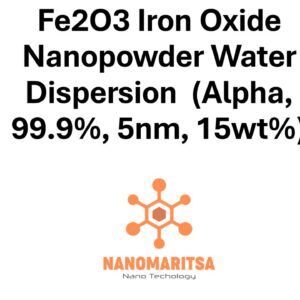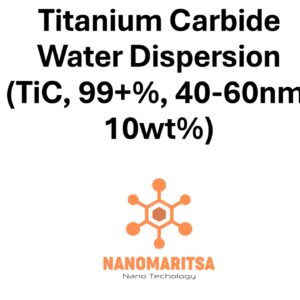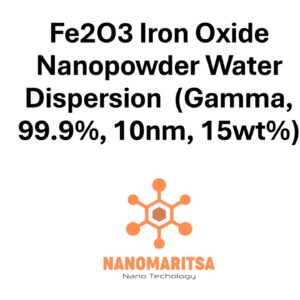Metal Oxide Dispersions
Antimony Oxide Nanopowder Water Dispersion ( Sb2O3, 20wt%, 80-200nm)
€130.00
CompareAntimony Oxide Nanopowder Water Dispersion (Sb₂O₃, 20 wt%, 80-200 nm) is a water-based dispersion that contains Antimony Oxide (Sb₂O₃) nanoparticles. Here are the key details and properties of this material:
1. Composition and Properties:
- Material: The dispersion contains Antimony Oxide (Sb₂O₃), which is an inorganic compound of antimony, commonly used in various industrial applications. Antimony Oxide exists in multiple forms, with Sb₂O₃ being the most common and stable oxide form.
- Purity: The product contains 20 wt% Antimony Oxide nanoparticles, ensuring a sufficient concentration of material for various applications.
- Particle Size: The nanoparticles have a size range of 80-200 nm. These relatively larger particles compared to typical nanomaterials still offer enhanced surface area and reactivity for specific applications.
- Dispersion: The material is in a water-based dispersion, meaning the Antimony Oxide nanoparticles are suspended in water, making it easier to handle, apply, and process in various manufacturing settings.
2. Key Features:
- Water-Based: Being water-based, this dispersion is environmentally friendly, non-toxic, and safer to handle compared to solvent-based dispersions, which often require additional precautions.
- Moderate Particle Size: The 80-200 nm particle size offers a moderate surface area compared to smaller nanoparticles. While not as reactive as nanoparticles with sub-50 nm sizes, this size range still provides increased surface area for various industrial applications.
- Moderate Concentration: The 20 wt% concentration of Antimony Oxide nanoparticles ensures sufficient material is available for applications requiring a moderate amount of antimony oxide.
3. Applications:
- Flame Retardants: Antimony Oxide is commonly used as a flame retardant in a variety of polymers, textiles, and coatings. It is typically combined with halogenated compounds to enhance flame resistance. The water-based dispersion allows easy incorporation of Sb₂O₃ into polymers and coatings during manufacturing.
- Ceramic Applications: Antimony Oxide nanoparticles are used in the manufacture of ceramics, such as in glazes and pigments. The nanoparticles contribute to properties like opacity, color, and thermal stability in ceramic materials.
- Glass and Optics: Antimony Oxide is used in the glass industry, where it helps improve the optical properties and refraction indices of certain glasses, especially in optical lenses and displays. The dispersion can be used for coating glass or adding to glass melts.
- Electronics: Antimony Oxide is employed in the electronics industry, particularly in semiconductor devices and thin films. It is used to enhance electrical conductivity and electronic properties in electrical components.
- Catalysis: Sb₂O₃ can serve as a catalyst or a catalyst precursor in various chemical processes, including oxidation and reduction reactions. The nanoparticles’ high surface area can enhance the reaction rate and selectivity in catalytic processes.
- Pigments and Dyes: Antimony Oxide nanoparticles are used in the pigment industry for producing white and opaque pigments in paints, coatings, and inks. The moderate size of the particles contributes to better control over the color properties in the final product.
- Battery Materials: There is research into the use of Antimony Oxide in the development of battery electrodes, particularly in lithium-ion batteries, where it can help improve the energy density and charging cycles of the battery.
4. Advantages:
- Water-Based: The water-based dispersion is safer, easier to handle, and more environmentally friendly compared to solvent-based dispersions. It eliminates the need for hazardous chemicals or organic solvents in handling and processing.
- Moderate Surface Area: The 80-200 nm particle size provides a balance between increased surface area and moderate reactivity. This makes it suitable for various applications, such as in flame retardants, ceramics, and electronics.
- Versatility: Antimony Oxide nanoparticles can be used in a range of industries, including electronics, flame retardant production, pigments, and catalysis, offering flexibility for different applications.
- Cost-Effective: The relatively larger particle size (compared to sub-10 nm nanoparticles) may result in a more cost-effective material, while still offering beneficial properties for industrial applications.
5. Handling and Storage:
- Storage: Store the dispersion in a cool, dry place, away from direct sunlight and heat sources. Make sure the container is sealed tightly to prevent the water from evaporating and the dispersion from settling.
- Handling: While the water-based dispersion is less hazardous than solvent-based products, it is still advisable to wear appropriate personal protective equipment (PPE), such as gloves and safety goggles, to avoid direct contact with the nanoparticles.
- Safety: Although Antimony Oxide is generally safe to handle in small quantities, it is important to avoid inhalation or ingestion of the powder. Work in a well-ventilated area and follow all safety instructions provided by the manufacturer.
6. Potential Limitations:
- Particle Size: The 80-200 nm particle size may limit the material’s application in industries requiring extremely high surface areas or where finer particles are needed for greater reactivity, such as in catalysis or nanotechnology.
- Stability: Like many nanopowder dispersions, there may be settling of particles over time. Regular stirring or agitation may be needed to ensure the uniformity of the dispersion before use.
Summary:
Antimony Oxide Nanopowder Water Dispersion (Sb₂O₃, 20 wt%, 80-200 nm) is a water-based dispersion containing Antimony Oxide (Sb₂O₃) nanoparticles. With 20 wt% concentration and a particle size range of 80-200 nm, it offers moderate surface area and reactivity. This dispersion is ideal for flame retardant applications, ceramics, glass, electronics, catalysis, and pigments. It is environmentally friendly, easy to handle, and provides a versatile material for various industries.
SKU: MN07NPD0152
Category: Metal Oxide Dispersions
| Measurement (ml) | 100 ml, 500 ml, 1000 ml |
|---|
Related products
-
Metal Oxide Dispersions
Fe2O3 Iron Oxide Nanopowder Water Dispersion (Alpha, 99.9%, 5nm, 15wt%)
0 out of 5(0)SKU: MN07NPD0120€280.00 This product has multiple variants. The options may be chosen on the product page -
Metal Oxide Dispersions
Titanium Carbide Water Dispersion (TiC, 99+%, 40-60nm, 10wt%)
0 out of 5(0)SKU: MN07NPD0118€90.00 This product has multiple variants. The options may be chosen on the product page -
Metal Oxide Dispersions
Fe2O3 Iron Oxide Nanopowder Water Dispersion (Gamma, 99.9%, 10nm, 15wt%)
0 out of 5(0)SKU: MN07NPD0124€280.00 This product has multiple variants. The options may be chosen on the product page -
Metal Oxide Dispersions
Titanium Oxide Nanopowder Water Dispersion (TiO2, Rutile, 15 wt%, 5-30 nm)
0 out of 5(0)SKU: MN07NPD0106€60.00 This product has multiple variants. The options may be chosen on the product page






